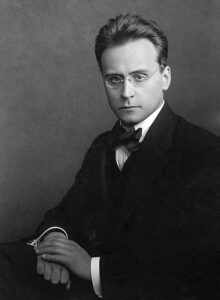Webern, Cinq Pièces
Five pieces in under six minutes—it says something about the sparseness of Webern’s music.
 The Austrian composer Anton Webern (1883-1945) is one of three primary figures in the Second Viennese School. Arnold Schoenberg and his acolytes Webern and Berg pioneered the compositional technique of twelve-tone serialism, achieving very different results.
The Austrian composer Anton Webern (1883-1945) is one of three primary figures in the Second Viennese School. Arnold Schoenberg and his acolytes Webern and Berg pioneered the compositional technique of twelve-tone serialism, achieving very different results.
Serialism is not everyone’s cup of tea. It does tend to evoke strong opinions. I’ve been to academic conferences where the music was praised to the heavens and others where it was dubbed the devil’s handiwork.
A few weeks ago, we featured Alban Berg’s Lyric Suite, and I noted that despite Berg’s serialism his music retains much of the appeal of late Romanticism. Webern requires us to listen for other things. He described one of his techniques as Klangfarbenmelodie, the idea that timbre (instrumental color) could be not just an expressive element, but a basis for musical structure. Instead of having a single or predominant instrument play the melodic line, the melody is distributed among various instruments so that it changes color as it progresses.
If you listen for traditional (hummable) melodies, you will be disappointed. But as an exploration in color and mood, this work has much to offer.
Webern composed the work in 1911. At about the same time, Schoenberg wrote in a preface to Webern’s Six Bagatelles:
One has to realize what restraint it needs to express oneself with such brevity. Every glance can be expanded into a poem, every sigh into a novel. But to express a novel in a single gesture, joy in a single breath; such concentration can only be found where self-pity is lacking in equal measure.



